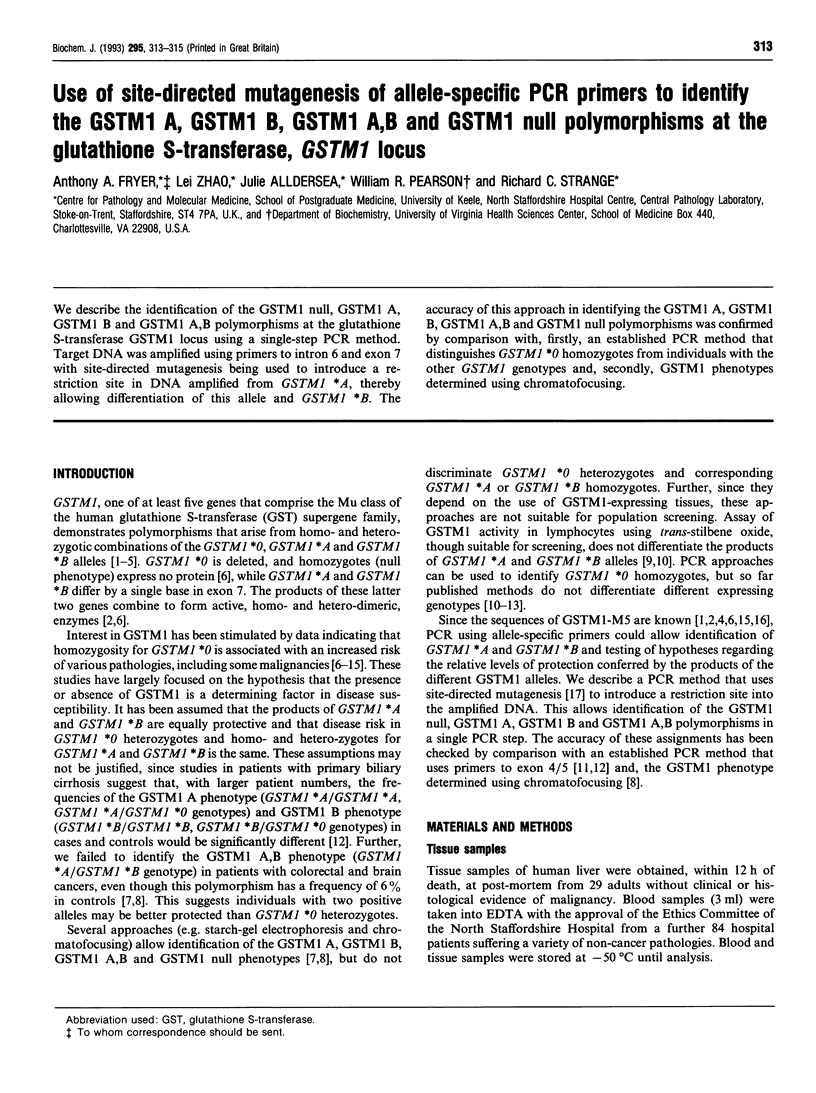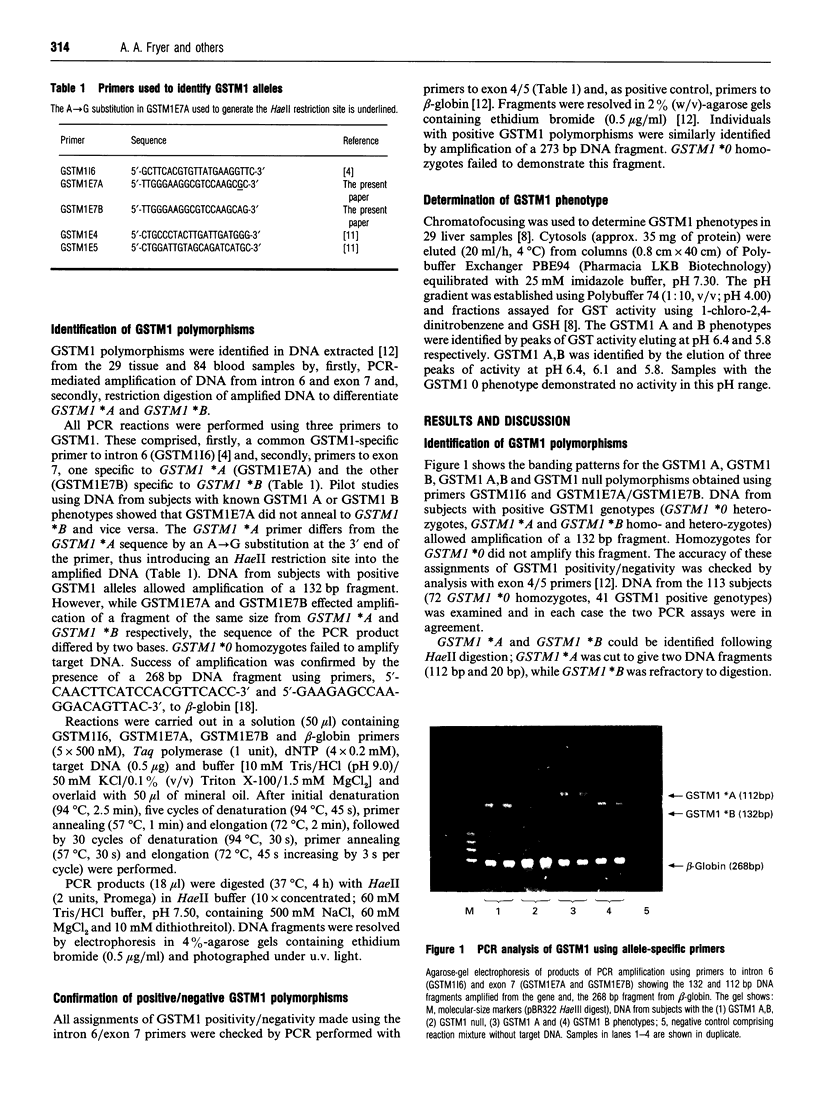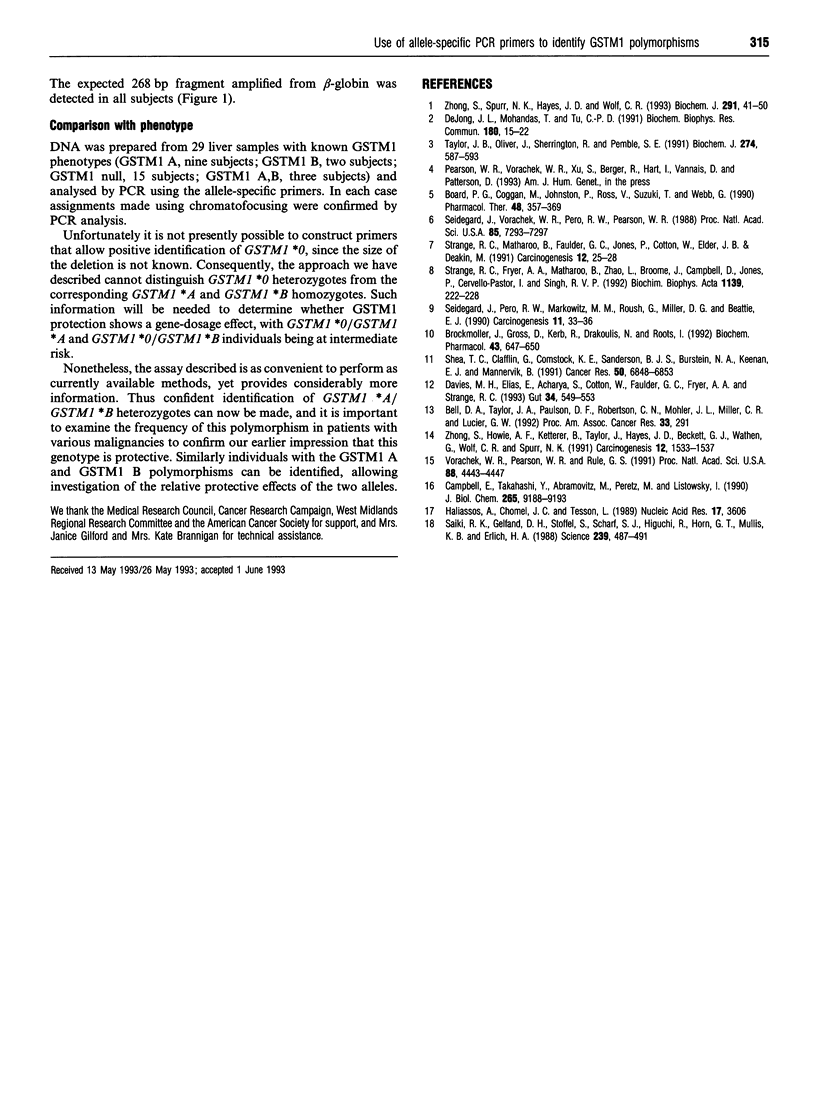Abstract
We describe the identification of the GSTM1 null, GSTM1 A, GSTM1 B and GSTM1 A,B polymorphisms at the glutathione S-transferase GSTM1 locus using a single-step PCR method. Target DNA was amplified using primers to intron 6 and exon 7 with site-directed mutagenesis being used to introduce a restriction site in DNA amplified from GSTM1 *A, thereby allowing differentiation of this allele and GSTM1 *B. The accuracy of this approach in identifying the GSTM1 A, GSTM1 B, GSTM1 A,B and GSTM1 null polymorphisms was confirmed by comparison with, firstly, an established PCR method that distinguishes GSTM1 *0 homozygotes from individuals with the other GSTM1 genotypes and, secondly, GSTM1 phenotypes determined using chromatofocusing.
Full text
PDF


Images in this article
Selected References
These references are in PubMed. This may not be the complete list of references from this article.
- Board P., Coggan M., Johnston P., Ross V., Suzuki T., Webb G. Genetic heterogeneity of the human glutathione transferases: a complex of gene families. Pharmacol Ther. 1990;48(3):357–369. doi: 10.1016/0163-7258(90)90054-6. [DOI] [PubMed] [Google Scholar]
- Brockmöller J., Gross D., Kerb R., Drakoulis N., Roots I. Correlation between trans-stilbene oxide-glutathione conjugation activity and the deletion mutation in the glutathione S-transferase class mu gene detected by polymerase chain reaction. Biochem Pharmacol. 1992 Feb 4;43(3):647–650. doi: 10.1016/0006-2952(92)90591-6. [DOI] [PubMed] [Google Scholar]
- Campbell E., Takahashi Y., Abramovitz M., Peretz M., Listowsky I. A distinct human testis and brain mu-class glutathione S-transferase. Molecular cloning and characterization of a form present even in individuals lacking hepatic type mu isoenzymes. J Biol Chem. 1990 Jun 5;265(16):9188–9193. [PubMed] [Google Scholar]
- Davies M. H., Elias E., Acharya S., Cotton W., Faulder G. C., Fryer A. A., Strange R. C. GSTM1 null polymorphism at the glutathione S-transferase M1 locus: phenotype and genotype studies in patients with primary biliary cirrhosis. Gut. 1993 Apr;34(4):549–553. doi: 10.1136/gut.34.4.549. [DOI] [PMC free article] [PubMed] [Google Scholar]
- DeJong J. L., Mohandas T., Tu C. P. The human Hb (mu) class glutathione S-transferases are encoded by a dispersed gene family. Biochem Biophys Res Commun. 1991 Oct 15;180(1):15–22. doi: 10.1016/s0006-291x(05)81248-3. [DOI] [PubMed] [Google Scholar]
- Haliassos A., Chomel J. C., Tesson L., Baudis M., Kruh J., Kaplan J. C., Kitzis A. Modification of enzymatically amplified DNA for the detection of point mutations. Nucleic Acids Res. 1989 May 11;17(9):3606–3606. doi: 10.1093/nar/17.9.3606. [DOI] [PMC free article] [PubMed] [Google Scholar]
- Saiki R. K., Gelfand D. H., Stoffel S., Scharf S. J., Higuchi R., Horn G. T., Mullis K. B., Erlich H. A. Primer-directed enzymatic amplification of DNA with a thermostable DNA polymerase. Science. 1988 Jan 29;239(4839):487–491. doi: 10.1126/science.2448875. [DOI] [PubMed] [Google Scholar]
- Seidegård J., Pero R. W., Markowitz M. M., Roush G., Miller D. G., Beattie E. J. Isoenzyme(s) of glutathione transferase (class Mu) as a marker for the susceptibility to lung cancer: a follow up study. Carcinogenesis. 1990 Jan;11(1):33–36. doi: 10.1093/carcin/11.1.33. [DOI] [PubMed] [Google Scholar]
- Seidegård J., Vorachek W. R., Pero R. W., Pearson W. R. Hereditary differences in the expression of the human glutathione transferase active on trans-stilbene oxide are due to a gene deletion. Proc Natl Acad Sci U S A. 1988 Oct;85(19):7293–7297. doi: 10.1073/pnas.85.19.7293. [DOI] [PMC free article] [PubMed] [Google Scholar]
- Shea T. C., Claflin G., Comstock K. E., Sanderson B. J., Burstein N. A., Keenan E. J., Mannervik B., Henner W. D. Glutathione transferase activity and isoenzyme composition in primary human breast cancers. Cancer Res. 1990 Nov 1;50(21):6848–6853. [PubMed] [Google Scholar]
- Strange R. C., Fryer A. A., Matharoo B., Zhao L., Broome J., Campbell D. A., Jones P., Pastor I. C., Singh R. V. The human glutathione S-transferases: comparison of isoenzyme expression in normal and astrocytoma brain. Biochim Biophys Acta. 1992 Jul 7;1139(3):222–228. doi: 10.1016/0925-4439(92)90138-d. [DOI] [PubMed] [Google Scholar]
- Strange R. C., Matharoo B., Faulder G. C., Jones P., Cotton W., Elder J. B., Deakin M. The human glutathione S-transferases: a case-control study of the incidence of the GST1 0 phenotype in patients with adenocarcinoma. Carcinogenesis. 1991 Jan;12(1):25–28. doi: 10.1093/carcin/12.1.25. [DOI] [PubMed] [Google Scholar]
- Taylor J. B., Oliver J., Sherrington R., Pemble S. E. Structure of human glutathione S-transferase class Mu genes. Biochem J. 1991 Mar 1;274(Pt 2):587–593. doi: 10.1042/bj2740587. [DOI] [PMC free article] [PubMed] [Google Scholar]
- Vorachek W. R., Pearson W. R., Rule G. S. Cloning, expression, and characterization of a class-mu glutathione transferase from human muscle, the product of the GST4 locus. Proc Natl Acad Sci U S A. 1991 May 15;88(10):4443–4447. doi: 10.1073/pnas.88.10.4443. [DOI] [PMC free article] [PubMed] [Google Scholar]
- Zhong S., Howie A. F., Ketterer B., Taylor J., Hayes J. D., Beckett G. J., Wathen C. G., Wolf C. R., Spurr N. K. Glutathione S-transferase mu locus: use of genotyping and phenotyping assays to assess association with lung cancer susceptibility. Carcinogenesis. 1991 Sep;12(9):1533–1537. doi: 10.1093/carcin/12.9.1533. [DOI] [PubMed] [Google Scholar]
- Zhong S., Spurr N. K., Hayes J. D., Wolf C. R. Deduced amino acid sequence, gene structure and chromosomal location of a novel human class Mu glutathione S-transferase, GSTM4. Biochem J. 1993 Apr 1;291(Pt 1):41–50. doi: 10.1042/bj2910041. [DOI] [PMC free article] [PubMed] [Google Scholar]



